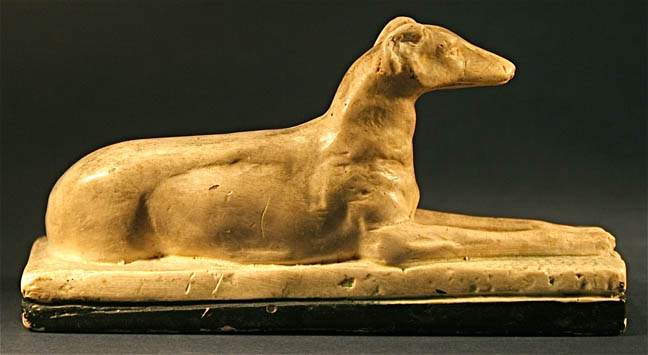

Title: Antique art deco clay pottery ceramic statue dog mold
Shipping: $29.00
Artist: N/A
Period: 20th Century
History: N/A
Origin: North America > United States
Condition: Very Good
Item Date: 1920 to 1930
Item ID: 3406
Beautiful little designed ceramic display terracotta statue this dog is posed in a strong and proud art deco posture. This dog is in fine condition with some chips but no cracks though there are some small marks from handling and past display. This statue dates from the late 1930s or earlier. An outstanding decorated art deco dog. The dog is constructed from wet clay molding and dry carving work. The animal’s fur is produced from numerous diagonally-incised lines. The surface is decorated in cream-colored clay. Clay animals are quite rare and have been increasingly difficult to find in the antiques market with out being broken. This dog has a great story and provenance, this example has some of the “BELLS” and whistles one looks for in a quality American antique clay pottery dog.
Terracotta, terra cotta or terra-cotta, a type of earthenware, is a clay-based unglazed or glazed ceramic, where the fired body is porous.
Link: http://en.wikipedia.org/wiki/Pottery
Pottery is made by forming a clay body into objects of a required shape and heating them to high temperatures in a kiln to induce reactions that lead to permanent changes, including increasing their strength and hardening and setting their shape. There are wide regional variations in the properties of clays used by potters and this often helps to produce wares that are unique in character to a locality. It is common for clays and other minerals to be mixed to produce clay bodies suited to specific purposes. Prior to some shaping processes, air trapped within the clay body needs to be removed. This is called de-airing and can be accomplished by a machine called a vacuum pug or manually by wedging. Wedging can also help to ensure an even moisture content throughout the body. Once a clay body has been de-aired or wedged, it is shaped by a variety of techniques. After shaping it is dried before firing. There are a number of stages in the drying process. Leather-hard refers to the stage when the clay object is approximately 75-85% dry. Clay bodies at this stage are very firm and only slightly pliable. Trimming and handle attachment often occurs at the leather-hard state. Clay bodies are said to be "bone-dry" when they reach a moisture content at or near 0%. Unfired objects are often termed greenware. Clay bodies at this stage are very fragile and hence can be easily broken. The quality of pottery has varied historically, in part dependent upon the repute in which the potter's craft was held by the community. For example, in the Chalcolithic period in Mesopotamia, Halafian pottery achieved a level of technical competence and sophistication, not seen until the later developments of Greek pottery with Corinthian and Attic ware. The distinctive Red Samian ware of the Early Roman Empire was copied by regional potters throughout the Empire. The Dark Age period saw a collapse in the quality of European pottery which did not recover in status and quality until the European Renaissance.